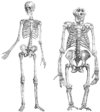Gorilla–human last common ancestor
| Gorilla–human last common ancestor Temporal range: 10–8 Ma | |
|---|---|
| Scientific classification | |
| Kingdom: | Animalia |
| Phylum: | Chordata |
| Class: | Mammalia |
| Order: | Primates |
| Infraorder: | Simiiformes |
| Superfamily: | Hominoidea |
| Family: | Hominidae |
| Subfamily: | Homininae |
| Type species | |
| Homo sapiens Linnaeus, 1758 | |
| Genera | |
|
Tribe Gorillini
Tribe Hominini | |
The gorilla–human last common ancestor (GHLCA, GLCA, or G/H LCA) is the last species that the tribes Hominini and Gorillini (i.e. the chimpanzee–human last common ancestor on one hand and gorillas on the other) share as a common ancestor. It is estimated to have lived 8 to 10 million years ago (TGHLCA) during the late Miocene.[1][2][3][4]
The fossil find of Nakalipithecus nakayamai are closest in age to the GHLCA.[3][4]
References
- ↑ Jha, Alok (March 7, 2012). "Gorilla genome analysis reveals new human links". The Guardian. Retrieved May 8, 2015.
- ↑ Jha, Alok (March 9, 2012). "Scientists unlock genetic code for gorillas - and show the human link". The Sydney Morning Herald. Retrieved May 8, 2015.
- 1 2 Hansford, Dave (November 13, 2007). "New Ape May Be Human-Gorilla Ancestor". National Geographic News. Retrieved May 8, 2015.
- 1 2 "Is This the Common Ancestor of Humans/Chimps/Gorillas?". Softpedia. November 13, 2007. Retrieved May 8, 2015.
See also
- Chimpanzee–human last common ancestor
- Orangutan–human last common ancestor
- Gibbon–human last common ancestor
- History of hominoid taxonomy
- List of human evolution fossils (with images)
| Wikispecies has information related to: Homininae |
This article is issued from Wikipedia - version of the 11/6/2016. The text is available under the Creative Commons Attribution/Share Alike but additional terms may apply for the media files.
